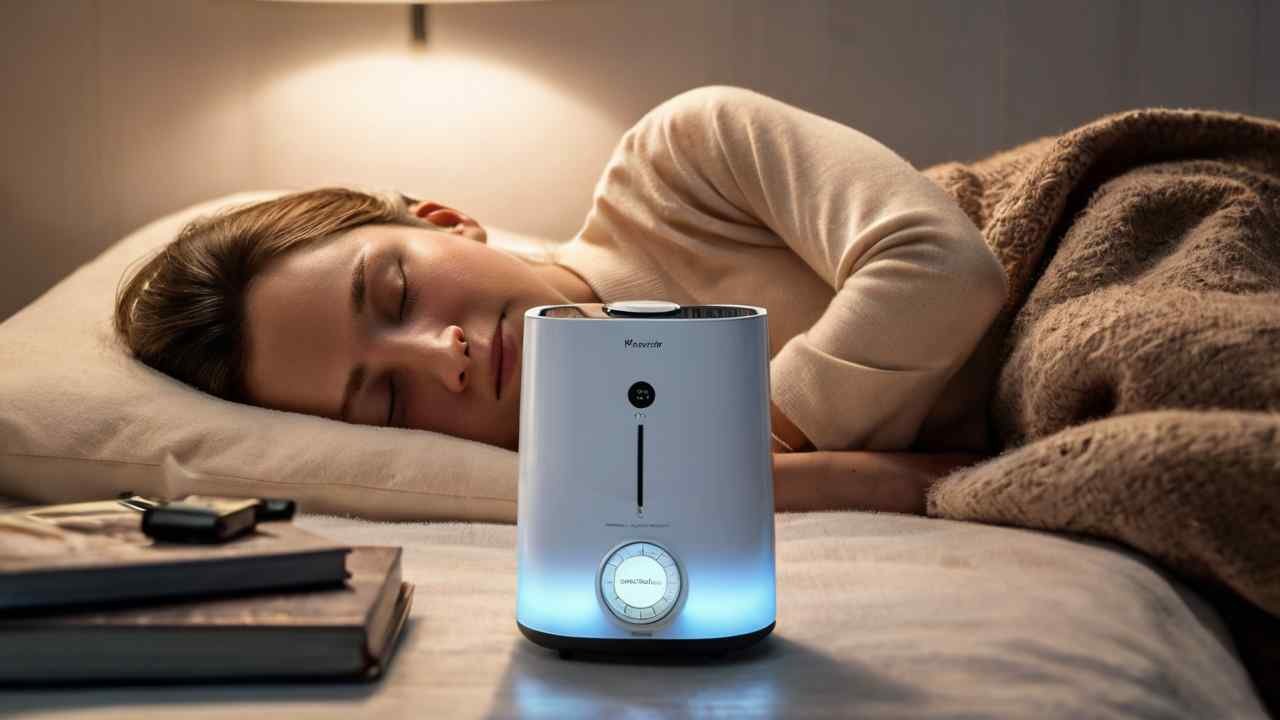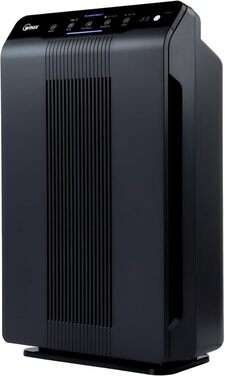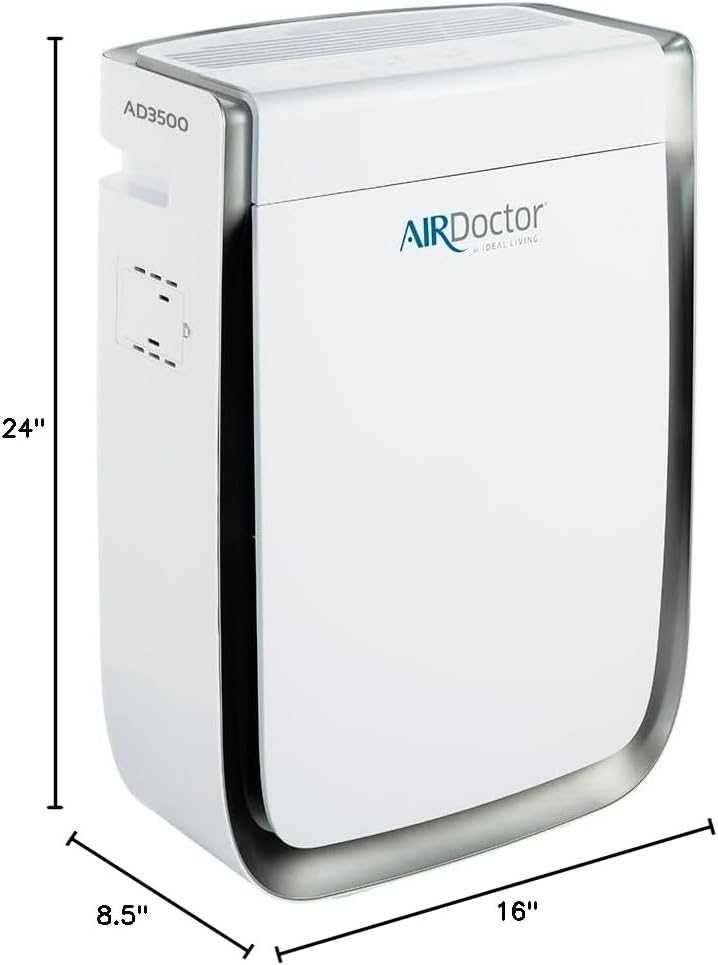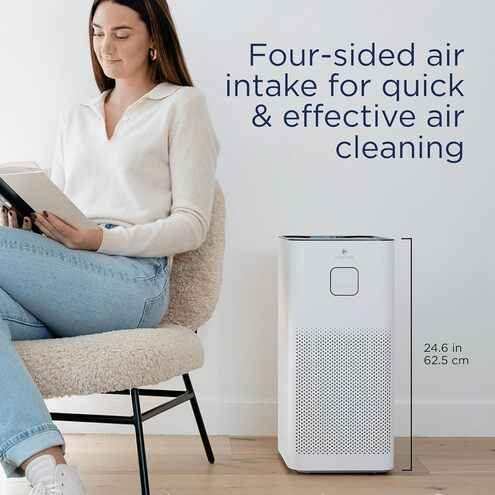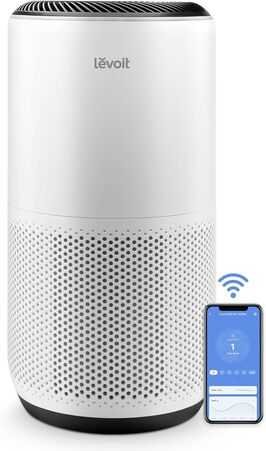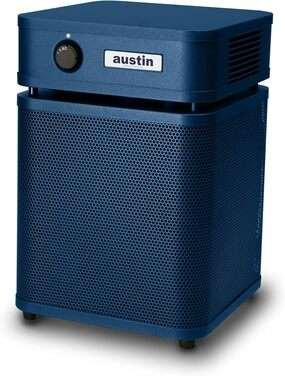Are you worried about your home’s air quality? In our busy world, air pollution is a big challenge. Keeping the air clean indoors is vital to our health. This is especially true in our bedrooms, where we relax and sleep.
Thanks to new tech, we now have home air purifiers. There are even ones meant for bedrooms. These come with HEPA filters. They can catch tiny particles, like allergens and bacteria, with 99.97% success.
In this guide, we’ll look at the perks and traits of home air purifiers. We’ll focus on portable models that turn your bedroom into a clean, fresh space. We’ll cover how air purifiers work, the different types of air purifiers, and how to pick the best one for you. We’ll also talk about maintenance and how air purifiers can help with asthma relief, remove smoke, and get rid of odors.
If you’re thinking about getting an air quality improvement tool, or just want to know more, this guide is for you. Let’s explore how home air purifiers can make your living space healthier and more pleasant.
Contents
- 1 Introduction
- 2 Why Indoor Air Quality Matters
- 3 How Air Purifiers Work
- 4 Benefits of Using an Air Purifier
- 5 Types of Air Purifiers
- 6 Choosing the Right Air Purifier for Your Home
- 7 Air Purifiers for Specific Needs
- 8 Top Air Purifier Brands and Models
- 9 Alen Air Purifier
- 10 Winix Air Purifier
- 11 AirDoctor Air Purifier
- 12 Medify Air Purifier
- 13 LEVOIT Air Purifier
- 14 Austin Air Purifier
- 15 Air Purifier Maintenance and Upkeep
- 16 Air Purifiers and Energy Efficiency
- 17 Combining Air Purifiers with Other Indoor Air Quality Solutions
- 18 Common Misconceptions About Air Purifiers
- 19 Air Purifiers for Different Rooms
- 20 The Future of Air Purification Technology
- 21 Real-Life Experiences and Testimonials
- 22 Conclusion
- 23 Frequently Asked Questions About Air Purifiers
- 23.1 How does an air purifier work?
- 23.2 What does an air purifier do?
- 23.3 Are air purifiers a waste of money?
- 23.4 Are air purifiers FSA eligible?
- 23.5 Do air purifiers dry the air?
- 23.6 Do air purifiers use a lot of electricity?
- 23.7 How many air purifiers do I need?
- 23.8 What are the benefits of using an air purifier?
- 23.9 What types of air purifiers are available?
- 23.10 How do I choose the right air purifier for my home?
- 23.11 How often should I maintain my air purifier?
- 23.12 What types of filters are most effective?
- 23.13 Can air purifiers help with allergies and asthma?
- 23.14 How often do I need to replace the filters?
- 23.15 Do air purifiers emit ozone?
Key Takeaways
- Air purifiers are key for keeping indoor air clean and healthy, especially in bedrooms.
- HEPA filters in air filtration devices can catch particles as small as 0.3 microns, removing allergens, dust, and more with high efficiency.
- Portable air filtration devices are handy, with things like handles and wheels for moving them around easily.
- Maintaining your air purifier, like cleaning or changing filters, is crucial for it to work well.
- Selecting an energy-efficient air purifier can help you save on electricity and is good for the planet.
Introduction
Today, indoor air pollution is a big problem. It can seriously impact our health. Air Quality Improvement Tools play a major role in making the air we breathe cleaner. Among them, VEWIOR Air Purifiers shine for their top-quality purifying systems.
Studies prove air purifiers are great at what they do. They help cut down on allergens, pollution, and can aid asthma. For example, a study by Chen et al. (2015) showed people breathing cleaner air had healthier hearts and lungs. Martenies and Batterman (2018) found better filters in schools and homes could help kids with asthma by reducing PM2.5.
VEWIOR Air Purifiers use the best filters like HEPA. These can catch nearly all tiny particles. That includes things like allergens, dust, and pet dander. With VEWIOR, the air in your home stays fresh and healthy.
| Study | Key Findings |
|---|---|
| Chen et al. (2015) | Reducing indoor particles of outdoor origin through air purifiers had cardiopulmonary benefits |
| Martenies and Batterman (2018) | Enhanced filters in schools and homes reduced indoor exposures to PM2.5 from outdoor sources, leading to health benefits for children with asthma |
| Vyas et al. (2016) | Air purifiers in Delhi during the winter of 2015-2016 showed potential improvements in indoor air quality |
| Park et al. (2017) | Air purifiers improved health outcomes and indoor particles in homes of children with allergic diseases in Fresno, California |
| Der Heide et al. (1999) | Air cleaners in homes of asthmatic children sensitized to pet allergens indicated improvements in health outcomes |
VEWIOR is all about keeping customers happy. They offer a satisfaction guarantee. This shows they believe in what they sell. If you’re not happy, they’ll make things right.
VEWIOR also cares deeply about the planet. Their products are made using eco-friendly materials. Plus, the filters can be changed. This decreases harm to the environment. By choosing VEWIOR, you’re caring for yourself and the Earth.
With VEWIOR Air Purifiers, every breath you take is a step towards a cleaner, healthier living space.
Do you deal with pet dander, bad smells, or want a nicer home air? VEWIOR Air Purifiers are here to help. Let VEWIOR improve your indoor air quality. They are your go-to for a purer air environment.
Why Indoor Air Quality Matters
We spend 90 percent of our lives inside, more than 54 years. The air we breathe indoors greatly affects our health. This is why indoor air quality matters so much.
Indoor air pollution can sometimes be worse than outside. Dust, pet dander, and more can make us sick. They can cause allergies, asthma, and other breathing issues.
Health Effects of Poor Indoor Air Quality
Indoor air pollution can lead to many health problems. Breathing bad air is linked to more heart and chest problems. It can also harm children’s lung health.
In places like India, asthma and lung diseases are common due to pollution. Even young children can get sick from the air.
Not only Air Quality, to ensure your home remains clean and healthy, follow our step-by-step guide on creating a smart cleaning routine. This will complement the benefits of using an air purifier.
Common Indoor Air Pollutants
Many things indoors can make us sick, including:
- Allergens like pet dander and pollen, which can cause allergies and make asthma worse.
- VOCs from paints and cleaning products, which can hurt our breathing.
- Mold spores, found in damp places, that can cause allergies and breathing problems.
- Bacteria and viruses, hidden in the air, that can make us sick.
- Smoke and smelly fumes from cooking, which can reduce the air quality.
| Pollutant | Health Effects |
|---|---|
| Particulate Matter (PM) | Respiratory issues, cardiovascular disease, premature death |
| Volatile Organic Compounds (VOCs) | Eye, nose, and throat irritation, headaches, nausea, liver and kidney damage |
| Nitrogen Dioxide (NO2) | Respiratory symptoms, increased asthma attacks |
| Carbon Monoxide (CO) | Fatigue, chest pain, impaired vision and coordination, death |
| Radon | Lung cancer |
Groups like ASHRAE set standards to make indoor air safer. They suggest ways to reduce harmful air. This includes ventilation and air filters.
Knowing about air pollutants helps us protect our health. Home purifiers with HEPA filters can remove many pollutants. This makes our homes healthier.
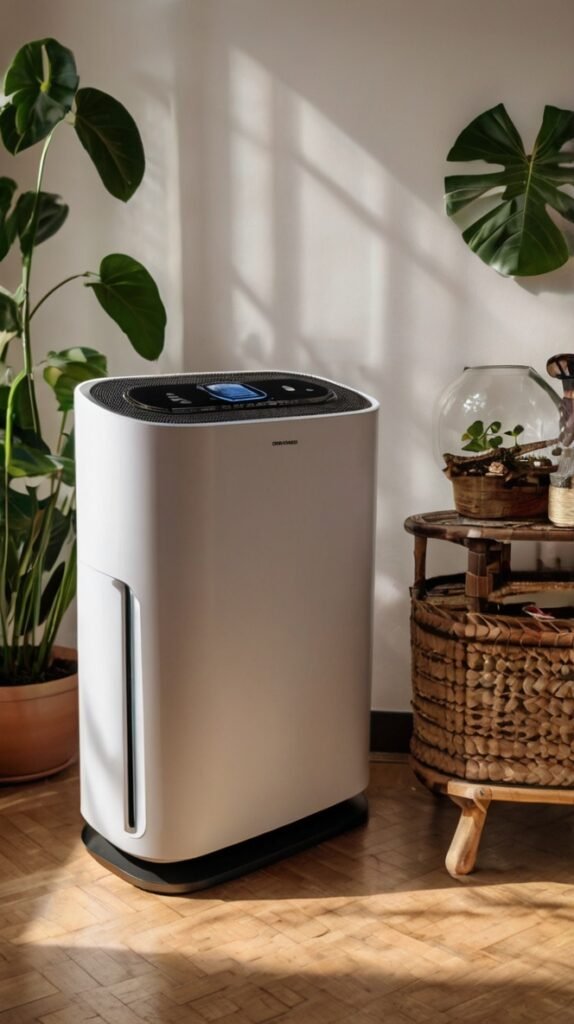
How Air Purifiers Work
Air cleaning device clean the air with a smart system. They use different filters and technologies to get rid of bad stuff in the air. Knowing how they work helps us pick the best one for our home or bedroom.
Filtration Methods
HEPA filters are a top choice for air purifiers. They can catch almost all particles larger than 0.3 microns. That includes dust, pollen, pet dander, and some germs. Look for filters with a MERV 13 rating for the best results.
Activated carbon filters are also great. They take care of smells, smoke, and VOCs. Together, HEPA and activated carbon filters make a powerful pair against air pollution.
Air Purification Technologies
Some air purifiers use special methods to clean the air even more. UV light purifiers use light to kill germs. The Carrier Infinity® purifier can take out 99% of certain germs and viruses.
Ionic purifiers send negative ions into the air. They make particles fall down. But, some might make harmful ozone. So, it’s safer to go with filters like HEPA and activated carbon.
| Air Purifier Technology | Effectiveness | Considerations |
|---|---|---|
| HEPA Filters | Trap 99.97% of particles 0.3 microns or larger | Require regular replacement (every 1-3 months) |
| Activated Carbon Filters | Capture odors, smoke, and VOCs | Work best in combination with HEPA filters |
| UV Light Purifiers | Kill microorganisms like fungal spores, bacteria, and viruses | Do not remove particles or odors |
| Ionic Air Purifiers | Remove airborne particles through ionization | May produce ozone gas, which can be harmful |
Smart air purifiers are the next level. They check the air quality and adjust themselves. They even let you control them with your phone. This makes keeping the air clean easy and efficient.
Knowing about different filters and technologies helps us find the best air purifier. Whether it’s HEPA, carbon, UV, or a mix, choosing the right one can make our home healthier. It’s a smart move for a better life quality.
Benefits of Using an Air Purifier
Buying an air purifier can make the air you breathe much better. It removes things like allergens and pet dander. This makes your home’s air cleaner and safer for your family.
Allergy & Asthma Relief
Air purifiers can help to improve indoor air quality by removing allergens such as pollen, dust mites, and pet dander. Pet dander refers to tiny skin flakes shed by animals, which can trigger allergic reactions in some individuals. Pollen is a fine powder produced by flowering plants, and dust mites are microscopic insects that live in dust and can also cause allergies. By removing these allergens from the air, air quality improvement tools can help to reduce symptoms of allergies and asthma, such as sneezing, coughing, itchy eyes, and difficulty breathing.
Smoke & Odor Removal
Air purifiers get rid of smoke and bad smells. They can handle tobacco smoke, cooking smells, and even wildfire smoke. These devices keep your home’s air fresh with the help of special filters for chemicals and odors.
Improved Air Quality
Air Filtration Systems lower the amount of pollution in the air. This is good for your health, from how you breathe to how you think. They can get rid of almost all tiny dust and dirt particles, making the air much cleaner.
| Pollutant | Removal Efficiency |
|---|---|
| Pollen, dust, and other particles (0.3 microns) | 99.97% (HEPA filters) |
| Viruses (coronavirus, flu strains) | Up to 99.99% (Molekule air purifiers) |
| Outdoor pollution (indoor penetration) | Reduced by 23% (HEPA filters) |
Reduced Risk of Respiratory Issues
Cleaner air means less chance of having breathing problems. Air Filtration Systems can lower the risk of asthma and bronchitis. They shield you from harmful stuff in the air, keeping your lungs safer and healthier.
Indoor air can be five times as polluted as outdoor air, as stated by the Environmental Protection Agency (EPA).
Air Filtration Systems help more than just your breathing. They also protect your mind and heart. Plus, they lower the risk of getting sick. So, getting one is a smart move for your health and living well.
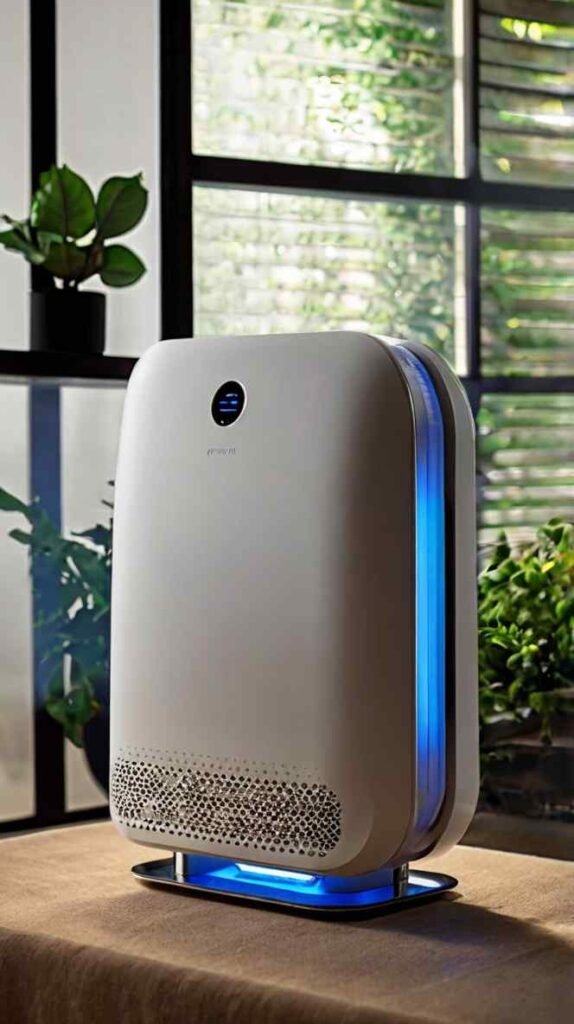
Types of Air Purifiers
Finding the right air purifier for your home is important. There are many types that use different methods. Each one is good for certain pollutants and allergens. Let’s look at the most common air filtration devices and what makes them special.
HEPA Air Purifiers
HEPA filters are the best at cleaning the air. They can remove 99.97% of tiny particles. This includes dust, pollen, and pet dander. HEPA air purifiers have been around for a long time and are very popular. You can find them for prices between $30 and $300.
Activated Carbon Air Purifiers
For getting rid of smells, activated carbon filters are a great choice. They absorb odors, smoke, and VOCs. These filters can make your air smell better, especially if you cook a lot or have pets. They typically cost $100 or more.
UV Light Air Purifiers
UV light air purifiers kill viruses and bacteria. By using UV light, they make the air healthier. But these purifiers can make ozone, which isn’t good to breathe. Make sure you pick one that’s safe.
Ionic Air Purifiers
Ionic air purifiers send charged ions into the air. This makes particles in the air fall down. They have different types, but some can make too much ozone. Make sure yours is safe.
| Type of Air Purifier | Key Features | Price Range |
|---|---|---|
| HEPA Air Purifiers | Removes 99.97% of particles as small as 0.3 microns | $30 to $300 |
| Activated Carbon Air Purifiers | Adsorbs odors, smoke, and VOCs | $100 and higher |
| UV Light Air Purifiers | Inactivates viruses, bacteria, and fungi | Varies |
| Ionic Air Purifiers | Releases negative ions to remove airborne pollutants | $30 to $300 |
If you want an excellent Air Filtration System for your bedroom, consider one with HEPA and carbon filters. This mix fights both allergens and smells. By knowing about different air filtration devices, you can choose wisely for your home.
Choosing the Right Air Purifier for Your Home
Choosing the perfect air purifier for your home involves looking at key details. This includes room size, how well it filters, its noise, and how energy-efficient it is. Thinking about these helps make sure you get the cleanest air.
Room Size Considerations
First, consider your room’s size when picking an air purifier. The right air purifier matches your room’s size to work best. Look for the Clean Air Delivery Rate (CADR) to find a good match. Pick a unit where the CADR is 2/3 the room’s size.
If you need to clean up spaces up to 600 square feet, check out VEWIOR’s air purifier. It’s perfect for keeping your home’s air fresh everywhere. It’s like having your very own clean air zone!
To get the most out of your air purifier, consider integrating it with other smart home devices. Our guide on the best smart home devices for beginners will help you make informed decisions.
Filtration Efficiency
Air purifiers clean the air through filters. Try to choose those with HEPA filters that can catch 99.97% of 0.3-micron particles. These filters are great for reducing dust, pollen, and other harmful things in the air.
| Filter Type | Particle Size Removed | Efficiency |
|---|---|---|
| True HEPA (North America) | 0.3 microns | 99.97% |
| True HEPA (Europe H13) | 0.3 microns | 99.95% |
Noise Levels
Noisy air purifiers are not fun. VEWIOR’s purifiers are as quiet as can be, ensuring a calm space. A quiet air filtration device is necessary for a good night’s sleep. Look for models that are silent, especially on low settings.
Energy Efficiency
Thinking about energy efficiency is key when picking an air filtration device. Models with an ENERGY STAR label are great. They save money and help the planet.
ENERGY STAR air purifiers can save a lot of energy. If they were all used in the U.S., over 9 billion pounds of greenhouse gases wouldn’t be released each year. That’s like not driving 900,000 cars.
Picking the right air purifier for your home comes down to size, how well it filters, its noise level, and its effect on your energy bill. The best one will let you and your family enjoy the cleanest air.
Air Purifiers for Specific Needs
Choosing the right Air Filtration System for your home is essential. Think about what you need, like fighting allergies, asthma, pet dander, or smoke. There’s an air filtration device for every issue.
For allergies or asthma, go for air purifiers with HEPA filters. These filters can catch tiny particles, including dust, pollen, and pet dander. They help reduce symptoms, making it easier to breathe at home.
Pet Owners
Pet owners have a tough job keeping the air clean. Pet hair, dander, and smells make it hard. Air Filtration Systems with HEPA and activated carbon filters can be a big help. They capture pet hair, dander, and get rid of smells.
Smoke and Odor Removal
If you have smoke from cooking or cigarettes, air filtration devices are great. They can remove the smell and harmful particles. Look for air purifiers that have HEPA and activated carbon filters. This combo works best.
| Air Purifier Type | Key Benefits | Ideal For |
|---|---|---|
| HEPA Air Purifiers | Captures 99.97% of particles as small as 0.3 microns | Allergies, asthma, dust, pollen |
| Activated Carbon Air Purifiers | Absorbs odors, smoke, and VOCs | Pet odors, cooking smells, smoke |
| UV Light Air Purifiers | Kills bacteria, viruses, and mold spores | Germaphobes, those with weakened immune systems |
| Ionic Air Purifiers | Produces negative ions to attract and neutralize pollutants | General air cleaning, odor reduction |
There’s an air purifier for every need. They help make your home healthier. Choosing the right one means you’re protecting your family’s health.
Top Air Purifier Brands and Models
Choosing the best air purifier is key for your home. Look at the top brands and models. These air quality improvement tools have proven to work well in removing bad stuff from the air. We’ll check out leading brands and their top models.
Alen Air Purifier
Alen makes top air purifiers. The Alen BreatheSmart Classic is great for big areas, up to 1,100 square feet. It uses a True HEPA filter to get rid of 99.97% of tiny particles. This helps remove allergens, dust, and smoke.
Winix Air Purifier
Winix offers many air purifiers for different needs. The Winix 5500-2 is a favorite, covering 360 square feet. It sports a True HEPA filter and PlasmaWave tech. This team fights off allergens, smoke, and smells in your bedroom or living room.
AirDoctor Air Purifier
AirDoctor is reliable for clean air. Their AirDoctor 4-in-1 Purifier works well in a 900-square-feet area. It has an UltraHEPA filter that can catch 99.97% of very small particles. This is good for fighting viruses, germs, and more.
Medify Air Purifier
Medify’s purifiers are strong and look nice. The Medify Air MA-40 is perfect for medium to big rooms, up to 840 square feet. It has a three-stage way to clean the air. This includes a True HEPA filter, activated carbon filter, and pre-filter. They help remove pollutants, odors, and VOCs well.
LEVOIT Air Purifier
LEVOIT has many varieties for you to choose from. The Levoit Core 300 is great for small to medium rooms. It has a three-stage system to clean the air. This includes a True HEPA filter and more for getting rid of bad stuff.
| Brand | Model | Key Features |
|---|---|---|
| Levoit | Core 600S | Removes 99.9% of particles, including those as small as 0.3 microns; features a three-stage True HEPA filtration system and an activated carbon filter |
| Levoit | Vital 200S | Four fan speeds, three modes (including a pet mode), and three different filters; removes hair, dust, cooking odors, and particles as small as 0.3 microns |
| Levoit | LV-H132 | Affordable option for small to medium-sized rooms; comes with a built-in dimmable nightlight |
| Molekule | Air Pro | Best for large rooms, covering spaces up to 1000 square feet; noted for its powerful performance and smart features |
| Coway | Airmega AP-1512HH Mighty | Recognized for saving energy; suitable for large rooms and features an eco mode for energy-conscious consumers |
| Dyson | Purifier Cool | Identified as best for cooling; a stylish and sleek air purifier appealing to users who appreciate smart, connected devices |
Austin Air Purifier
Austin Air makes strong, long-lasting purifiers. The Austin Air HealthMate can handle big spaces, up to 1,500 square feet. It uses a True HEPA filter and more. This makes it great at removing many kinds of pollutants and smells.
Think about room size, your needs, and the features you want when picking an air purifier. A top air filtration device from a good brand will keep your air clean and healthy. This is good for you and everyone at home.
Air Purifier Maintenance and Upkeep
It’s important to take care of our air purifiers. This way, they keep our air clean and healthy. We must look after them so they work well for a long time.
Cleaning and Replacing Filters
Filters are the most important part of an air quality improvement tool. HEPA filters capture 99.97% of tiny particles. Activated carbon filters absorb strong smells. But remember, filters need to be cleaned or changed often.
How often you clean filters depends on your air quality. If the air is bad, change them every 3-6 months. In cleaner places, filters can last 6-12 months.
Maintain your pre-filters every 1-3 weeks and change them every 1-3 months. Main filters might need changing every 6-12 months. Activated carbon filters should be replaced every 3–6 months.
Always clean filters as the manual says. Tap out the dust from pre-filters and rinse them. Activated carbon filters can be washed and dried. If they’re very dirty, you must replace them. HEPA filters need a gentle wash and should be replaced yearly.
Optimizing Air Purifier Performance
There are more things we can do to keep air quality improvement tools working well. Wipe the outside with a damp cloth every 2–4 weeks. For a deep clean, use a bleach and water mix.
Some air filtration devices show when filters need replacing. For example, Levoit devices have a light that comes on every 6-12 months. Always replace filters right away when you see this.
Do a big clean on your air purifier once a year. This means cleaning inside and out. Let it run a lot to keep the air fresh.
| Filter Type | Cleaning Frequency | Replacement Frequency |
|---|---|---|
| Pre-filter | Every 1-3 weeks (vacuuming) | Every 1-3 months |
| HEPA filter | Every 3-6 months (hand washing) | Every 8-12 months |
| Activated carbon filter | Shake and wash with water | Every 3-6 months |
Follow these steps to keep your air filtration device and air at home clean. A good air purifier helps us live better without allergens.
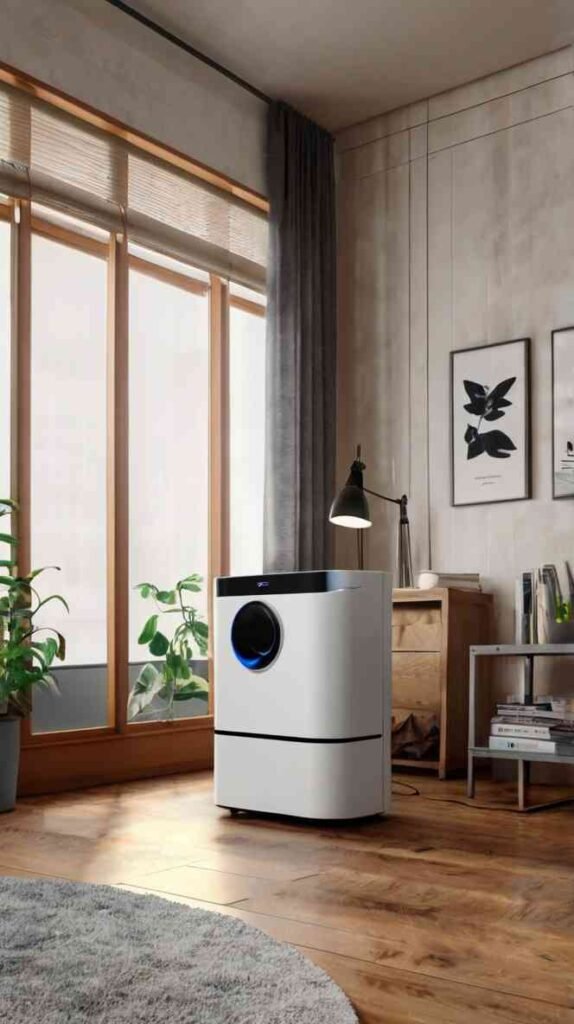
Air Purifiers and Energy Efficiency
Air purifiers help keep our homes healthy by removing bad stuff from the air. But we should also look at how much energy they use. It’s important they don’t add too much to our power bill or hurt the planet.
Some air filtration devices can use a lot of electricity. They might use 550 kWh a year if you run them all the time. This means you might pay more for electricity and leave a bigger carbon footprint. Luckily, there are now models that use less energy but still work well.
ENERGY STAR air purifiers are super energy-efficient. They use over 25% less energy than standard ones. This can save you 120 kWh and $15 a year on bills. Plus, you could save up to $120 during its life.
“By choosing an ENERGY STAR certified room air cleaner, you can enjoy the benefits of clean, healthy air while also reducing your energy consumption and contributing to a greener planet.”
One way to measure an air filtration device’s efficiency is by its Clean Air Delivery Rate (CADR). A higher CADR means it cleans more of the air faster. Portable air purifiers are great for one room. They clean well and use less energy.
| Air Purifier Model | Power Consumption (Watts) | Annual Energy Consumption (kWh) | Annual Energy Cost (at 15¢/kWh) |
|---|---|---|---|
| Sanalife’s Beyond Guardian | 80W (max fan speed) | 701 kWh | $105.19 |
| Commercial Air Purifier (without Energy Star) | 350W – 400W | 3,000+ kWh | $450+ |
| Aerus Guardian Angel | 16W – 28W | 248.20 kWh | $42.88 (in Massachusetts) |
We can find how much energy an air purifier uses with this formula:
E = P * (t/1000)
Here, E is energy use in kWh, P is power in watts, and t is hours used. For the Aerus Guardian Angel, with 16W to 28W used and on 24/7, it uses 0.68 kWh a day. Monthly, that’s about 21.10 kWh, and yearly is 248.20 kWh.
Electricity prices change by place, so costs vary. The U.S. Energy Information Administration has data on the average cost per kWh. This helps us figure out how much our air quality improvement tool will cost to run based on where we live.
Buying an energy-efficient air purifier is good for the air, our planet, and saving money. As we care about ourselves and the Earth, choosing a low-energy air quality improvement tool is smart.
Combining Air Purifiers with Other Indoor Air Quality Solutions
Air purifiers are great and make the air clean inside your home. They do even better when you also use other ways to help keep the air quality high. This means looking at different ways to make the inside air healthy.
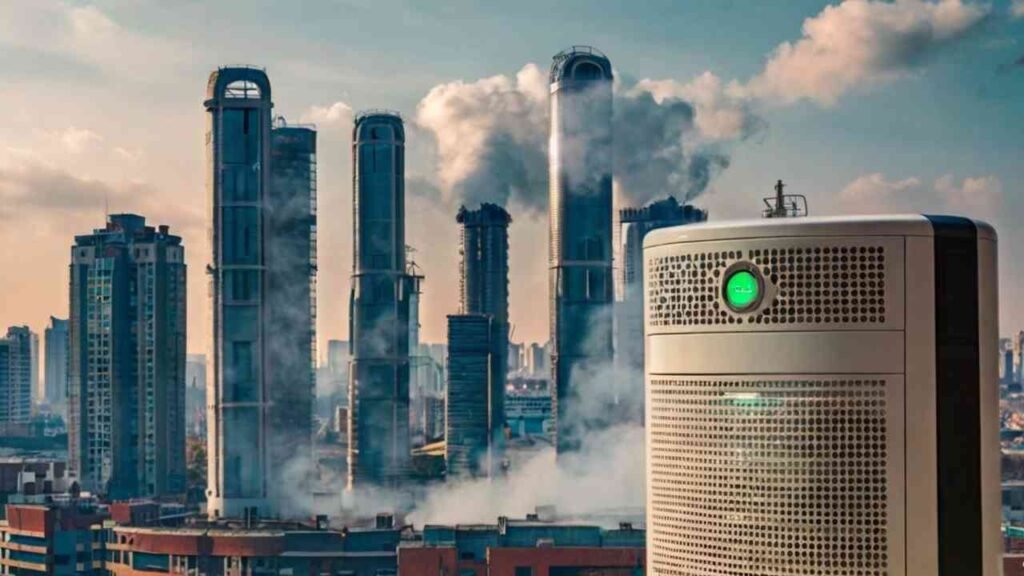
Humidifiers and Dehumidifiers
Keeping the right amount of moisture in the air is key for air quality. Humidifiers help by adding moisture, which stops the air from being too dry and hurting your breathing. Dehumidifiers, on the other hand, take out extra moisture, which helps avoid mold and allergens. Together with air purifiers, they make sure your air is just right for your health.
Ventilation and Air Circulation
Good flow of air and fresh air coming in are crucial for indoor air quality. Opening windows and using fans move fresh air in and old, bad air out. But, if outside air is very dirty or it’s allergy season, air purifiers can clean the air before you breathe it in.
There’s a study that shows doing certain things at home can help kids with asthma and allergies. Using air cleaners and special mattress covers can make a big difference. An example is using HEPA air cleaners to help asthmatic kids with pet allergies breathe better.
| Filter Type | Benefits |
|---|---|
| MERV 11 | Recommended for allergy relief |
| MERV 13 | Suggested for individuals with asthma or COPD |
| MERV 7 Carbon Filter | Effective for odor elimination |
| HEPA Filter | Captures small particles like allergens, bacteria, and viruses |
Remember, you must change your air filters often to keep your air clean. Combining air filters with air purifiers is a smart way to make sure the air in your home stays fresh and healthy.
By adding humidifiers, dehumidifiers, and good air flow to your air purifier, you cover many bases for clean air. This complete way of thinking about air quality helps your family stay healthy and breathe well at home.
Common Misconceptions About Air Purifiers
It’s crucial to know fact from fiction about air cleaning devices for a healthy home. Many folks ask, “Are air purifiers a waste of money?” or “Do air purifiers dry the air?” We’ll clear up these myths about air purifiers and reveal the truth.

Some think air purifiers make the air too dry and can cause sickness. But, most new air purifiers, unlike old ozone generators, are safe. They work well using HEPA filters and activated carbon. They clean the air without making it too dry.
Folks might believe just cleaning a lot and using the HVAC keeps indoor air clean. But, only air purifiers catch tiny particles like allergens, viruses, and bacteria really well. The best air purifiers can eliminate almost all particles as tiny as 0.3 microns, making your air cleaner.
“Air purifiers with a HEPA H14 filter can remove over 99.997% of particulates that are at least 0.3 microns in size, making them far more effective than relying solely on housecleaning or HVAC systems.”
Many think plants alone are enough to clean the air. While true plants help, air purifiers do a better job. They’re built to take out many different pollutants and work well in polluted places.
Remember, not every air cleaning device works the same. An air purifier’s quality depends on its filters, the number of filters, and extra tech like UV-C light. Picking the right air filtration system means looking at what it offers. This way, you get one that really does what you need.
| Misconception | Fact |
|---|---|
| Air purifiers cause sickness by drying the air | Modern air cleaning devices use safe filtration methods that don’t alter humidity levels |
| Housecleaning and HVAC systems are enough for air purification | Air purifiers are more effective in capturing tiny particles like allergens and bacteria |
| Plants can replace air purifiers | While beneficial, plants have limited air purification capabilities compared to dedicated air purifiers |
| All air purifiers are equally effective | Air purifier effectiveness varies based on factors like filtration technology and the number of filtration stages |
Knowing the truth about air cleaning devices helps us choose the best for our homes. The right air purifier can make our indoor air much healthier. This leads to a comfier and better living space.
Air Purifiers for Different Rooms
Choosing the best air purifier for your home means understanding each room’s needs. While all air filtration systems help clean the air, portable ones bring flexibility. These small units are easy to move, ideal for the bedroom, living space, or office.
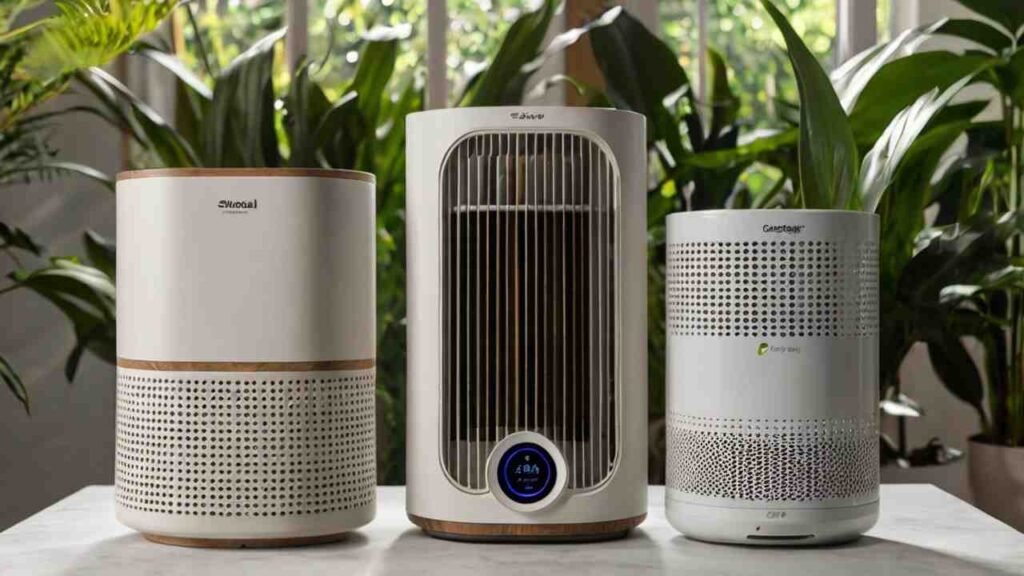
Bedrooms
Your bedroom should have a silent air purifier. Ensure it has a HEPA filter to catch tiny particles, making your sleep area allergen-free. Also, pick purifiers with charcoal filters to get rid of smells. Keep the purifier close to you, without blockages, for better air flow.
Living Rooms
The living room is where everyone gathers. Use a powerful air cleaning device here, especially for larger areas. PECO purifiers are great for big spaces, cleaning a lot of air efficiently. For the best results, keep it in the open, not blocked by furniture.
Home Offices
Home offices need to be clean for better work. HEPA filter air purifiers help by removing dust and allergens. For small offices, a quality HEPA purifier is enough. Put it near where you work, without blocking your space.
| Room Type | Recommended Air Purifier | Key Features |
|---|---|---|
| Bedroom | HEPA air purifier with activated carbon filter | Quiet operation, odor removal, 99.97% particle capture |
| Living Room | PECO air purifier for rooms > 1500 sq. ft. | High CADR, tackles various pollutants, central placement |
| Home Office | HEPA air purifier for rooms | Removes dust and allergens, improves concentration |
To decide on air cleaning devices, look at your home’s size and design. For big homes, whole-house purifiers might be best. Yet, for many, placing portable purifiers strategically is a good idea. This improves the air where you are most, making your home healthier.
The Future of Air Purification Technology
In the future, air purifiers will get even better. Smart air purifiers are gaining popularity. They can check the air and adjust to keep it clean, saving energy too.
New tech like nanofilters and green materials will change how we clean our air. Nanofilters can catch tiny particles better. AlgenAir’s aerium air purifier uses algae to clean dangerous gases and pollutants in small places.
Yet, some tech faces problems, like making sure it works bright light and staying active. But, experts are working to solve these issues and make these new methods the best they can be.
The future of clean air is more than just machines. Now, there are wearable gadgets, like Hari Hats, that keep your air clean when you move. This helps people with breathing issues and those who want to stay healthy.
People want greener, more efficient air purifiers. They also want devices that work well with their smart homes and phones. Companies are meeting this demand by making new purifiers that use less energy.
| Traditional Air Purifiers | Future Air Purification Technologies |
|---|---|
| Require regular filter changes | Nanotechnology filters with enhanced durability |
| Limited smart features | Integration with smart home systems and IoT |
| Higher energy consumption | Energy-efficient designs and automatic adjustments |
| Focus on indoor air purification | Wearable technologies for personal protection |
Using new air cleaning tech can be costly and need care. There are also rules and privacy to think about. Yet, as tech gets better, these solutions should be easier and cheaper to get.
The future of air clean-up looks promising. Smart air purifiers will grow smarter and more a part of our lives. This means cleaner air indoors for us all, promoting health and keeping us safe from air problems.
Real-Life Experiences and Testimonials
Customers’ reviews tell us a lot about air purifiers. They often share how their air got cleaner and they felt better. These stories show air cleaning devices can make a big difference.
One person got a REME-HALO for their home. They noticed less pet smells and kitchen odors. Plus, their allergies got better. Another user found they needed to change filters less often after adding a REME Halo to their home. It shows the system really works at catching bad stuff in the air.
But, one of the best stories is about a skunk spray. A cat got sprayed outside, but the REME Halo cleared the smell in just two hours. It proves how good it is at removing tough odors.
“The AirDoctor 3000 has been a game-changer for our family. With its high CADR rating and UltraHEPA filtration, we can breathe easier knowing that even the tiniest particles are being captured. The air in our home feels so much cleaner now!”
At Belvedere Animal Hospital, the air got cleaner too. They use air purifiers now and everyone can tell the difference. Animals and the people who care for them are in a safer, nicer space.
| Air Purifier | Key Features | Customer Experience |
|---|---|---|
| REME-HALO | Reduces odors and allergens | Significantly reduced pet and kitchen odors, alleviated allergy symptoms |
| AirDoctor 3000 | High CADR rating, UltraHEPA filtration | Removed 99.99% of viruses and bacteria in an air chamber test |
| RGF’s PHI Technology | Virus and microbe protection | Utilized by Oulun Kärpät ice hockey team for shared facility safety |
Stories and reviews like these make the benefits of air purifiers clear. They help in homes and workplaces by making the air cleaner. This means fewer allergens, less smell, and better air for all.
| Air Purifier Feature | Benefit |
|---|---|
| HEPA Filters | Remove 99.97% of particles 0.3 microns or larger, ideal for allergies and asthma |
| Activated Carbon Filters | Highly effective at removing odors from smoke, pets, food, and other sources |
| Pre-Filters | Capture larger particles, extending the life of other filters and maintaining efficiency |
| UV-C Light | Helps kill bacteria, viruses, and other microorganisms in the air |
According to the EPA, indoor air quality can be 100 times worse than outdoor air. This is important because we spend most of our time inside. Keeping the air clean at home is vital for our health.
Knowing how air purifiers work and their benefits helps you choose wisely. Pick one that suits your needs and keep it well-maintained. Follow the manufacturer’s tips for the best performance.
Conclusion
Buying a good home air purifier is a great choice, especially if it’s for your bedroom. It can make you feel better by removing bad stuff from the air. This lets you breathe better and have a more restful sleep. Look for features like HEPA filters, which catch most particles, and a high MERV rating for better cleaning. The air purifier should clean a big part of your room’s air, especially when there’s wildfire smoke around.
Keeping your air cleaning device in good shape is key to it working well. Follow the maker’s advice on changing filters and keep it clean. Even though air purifiers help with lots of allergens, remember they might not get rid of everything. For the best outcome, fix the real issues and use the purifier as a plus.
There are many air purifiers to choose from, like those with HEPA filters or others using new tech. It’s vital to pick one that fits your needs, considering room size, noise, and cost. Doing your homework and looking after your pick can really make your home’s air better. This way, you enjoy a healthier space that brings many joys.
Frequently Asked Questions About Air Purifiers
As we look into air cleaning devices, it’s common to wonder how they function and their advantages. We’ll tackle the main points on air purifiers here.
How does an air purifier work?
Air purifiers pull in air from the room. Then, they push it through filters. These filters remove things like dust and allergens. The clean air goes back into the room. This makes the air inside better to breathe.
What does an air purifier do?
Air cleaning devices clean the air by taking out bad stuff like dust and pollen. They make the air healthier for us to breathe. This help keeps our indoor space comfortable and good for our health.
Are air purifiers a waste of money?
Air purifiers can be a good buy if you choose the right one. They help by improving the air we breathe. This can ease allergy or asthma problems. Making sure you pick a quality air purifier for your needs is key.
Are air purifiers FSA eligible?
You might get reimbursed for an air purifier through your Flexible Spending Account (FSA). This is if it helps with allergies or asthma. Check with your FSA provider first, and see if your healthcare provider needs to give you any papers.
Do air purifiers dry the air?
Air purifiers do not make the air drier. They filter the air without taking away moisture. If you’re feeling dry, things like heating or low humidity might be the cause, not the air purifier.
Do air purifiers use a lot of electricity?
How much electricity an air purifier uses can change. It depends on its size and how it filters the air. Many today are made to not use a lot of power. Picking one with an Energy Star label can help keep your electric bill low.
How many air purifiers do I need?
You might need more than one air purifier based on your home’s size. Have one for each room you use the most. This is especially true for places like bedrooms and living rooms. It helps keep the air clean where you are most often.
What are the benefits of using an air purifier?
Air purifiers bring several benefits. They improve the air we breathe, help with allergies and asthma, and take away smoke and bad smells. They also lower the harmful things in the air. This means a better, healthier place to live.
What types of air purifiers are available?
You can find many kinds of air cleaning devices. Some use HEPA filters, while others use UV light. Each type is good at taking out different pollutants from the air. Pick the one that best fits your needs.
How do I choose the right air purifier for my home?
To pick the best air purifier, think about the room’s size and what you want to filter out. Choose one with a HEPA filter for best results. Also, look for ones with good efficiency and noise levels. Reputable certifications from groups like AHAM are a good sign, too.
How often should I maintain my air purifier?
It’s vital to keep your air cleaning device in good working order. Follow the guidelines to clean or change the filters. This is usually every few months to once a year. Don’t forget to keep the outside and the vents clean from dust. This keeps the air purifier working well.
What types of filters are most effective?
Filters like HEPA are great at catching tiny bits, up to 99.97%. Activated carbon is best for smells and gases. The best air purifiers use both kinds for top results.
Can air purifiers help with allergies and asthma?
Absolutely, air filtration systems can make life easier for those with allergies or asthma. They get rid of allergens in the air, like pollen and dust. This can help lower allergy symptoms.
How often do I need to replace the filters?
How often you swap the filters depends on the model and filter quality. HEPA filters last 3 to 5 years usually. Cheaper filters may need changing more. It’s important to keep an eye on the manufacturer’s advice for filter changes.
Do air purifiers emit ozone?
Some air filtration systems might release a bit of ozone, especially those with certain features. But, many new models are made to emit very little ozone and are considered safe. If you’re worried about this, choose air purifiers with certified HEPA filters and avoid ones that make ozone on purpose.

